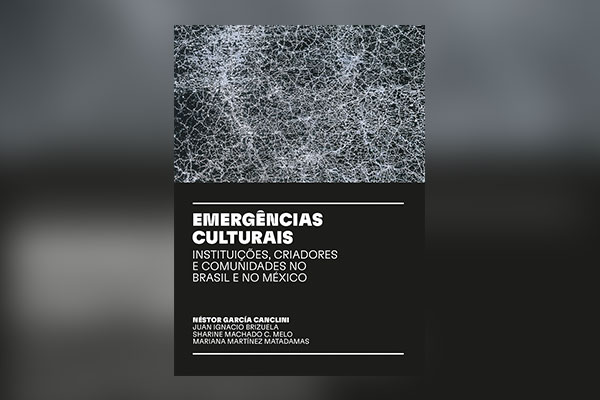
Millions of jobs in the cultural sector were hit hard in the most critical period of the covid-19 pandemic. During confinement, technological advances and new public habits accelerated changes in the cultural industry and provoked a review of funding, public policies and exhibition strategies, among other issues. In order to analyze this scenario, the Editora da Universidade de São Paulo (edusp), in co-edition with the Institute of Advanced Studies at USP (IEA-USP), recently launched the book Cultural Emergencies: Institutions, Creators and Communities in Brazil and Mexico. Made in partnership with Itaú Cultural, the publication was organized by Argentine anthropologist Néstor García Canclini and also includes the participation of researchers Juan Ignacio Brizuela, Sharine Machado C. Melo and Mariana Martínez Matadamas.
A arte!brasileiros spoke with professor Canclini – who has been studying crises in cultural institutions and artistic movements for about 20 years – about the main conclusions of Cultural Emergencies and extrapolated what is covered by the book in order to discuss other urgent aspects of the cultural sector at the moment and in the near future. Read next.

ARTE!✱ – What are the biggest challenges encountered throughout this research process? Were there also surprises, positive and/or negative?
Nestor Garcia Canclini – Something that was very significant to be able to compare two giant countries like Brazil and Mexico, with cultural policies of many decades, quite structured, with investigations already done in each of the two, however, with contrasts. This confrontation, in a situation like the pandemic, revealed countless surprises. In the case of Brazil, there are more studies on the relationship with Argentina, the importance of Brazil within Mercosur, but few analyzes and comparisons with Mexico. And, in the case of Mexico, there is a focus on the economy, culture and immigration, but more with the United States than with Latin America.
Another important surprise was discovering that during the Bolsonaro government, Brazil was, during the pandemic, the country that delivered the most emergency funds for cultural activities throughout Latin America. There is a comparative study, which was carried out in the first year of the pandemic, in relation to emergency increases in the culture budget in ten Latin American countries. Brazil is in first place, with a real increase of 143% in the fund dedicated to culture in 2020. Next comes Argentina, with 41%, third, Ecuador, with 24%, and fourth, Chile, with 15 %.
I would like to briefly mention two main explanations that give Brazil such a prominent place. First of all, we know that the Bolsonaro government was not favorable to cultural development, it demoted the Ministry of Culture to a Secretariat and, with that, reduced funds. However, we have to say that there are two main explanations, which we highlight and analyze in the book: in Brazil, a movement of thousands of artists, creators, managers and cultural animators emerges right at the beginning of the pandemic. The pandemic begins in March 2020 and, in April, virtual movements are already being created, which was the only way to communicate for most museums, cultural centers, etc. The public could not go to cinemas, theaters, etc., but did so virtually.
There were thousands of artists and cultural managers who got together to see where they could get funds, ask in a solidary and collective way, and even wrote a law, Aldir Blanc, which was proposed to Congress, because they knew that the best path was not the Secretariat of Culture nor the Executive Government, but the Congress, where there was plurality and there were many legislators willing to collaborate with these virtual networks, to write the Aldir Blanc law, which delivered more than R$ 3 billion, that is, about US $500 million, to distribute them in municipalities and states. There were obstacles, including from the government's Secretariat of Culture, through the complexity of budget usage requirements. Also because of the financial control details they established, but the money was distributed to approximately 75% of the municipalities.
This huge mobilization, which achieved the highest fundraising in Latin America, was the result of a sociocultural organization of artists and cultural managers, which had been taking place in Brazil since 2004, when the Pontos de Cultura in Brazil and a national cultural system were created from an initiative of the Ministry of Culture headed by Gilberto Gil.
The second important explanation we find is the federalization of the national cultural system in Brazil. It is a very different federalization compared to what happens in Mexico, which is a very centralized state. We know that this federalization, during the pandemic, favored, for example, states buying vaccines independently.
ARTE!✱ – Between the neoliberal crisis, the pandemic and the impact of new technologies, which factor proves to be the most forceful about the relationships between institutions, artists, public policies and the public itself? Will the recent emergence of artificial intelligence reconfigure this scenario in any way?
Canclini – The question is very important because it identifies three factors that are internationally significant for cultural development. I would say that the three, and the pandemic has the temporal limitation of having affected some countries severely, for two years cultural development, but the world health organization declared about a year ago that it was no longer the main social and economic problem in the world. The pandemic is not, at this moment, a decisive issue for cultural development, as are the neoliberal crisis and the impact of new technologies. This does not mean that the pandemic does not continue to show its consequences, because there are many that had to be closed. In the first year, on average, more than 800 jobs were lost in Latin America.
The latest technologies like ChatGPT show that artists are losing work and increasing manipulative audience orientation for the benefit of corporations and the mass audience. However, there is an articulating role that virtual technology facilitates for social movements, such as this movement that we mentioned in Brazil of artists and cultural managers mobilized in an emergency and that obtain funds and public through non-traditional ways. As for artificial intelligence, it's too early to evaluate this technology, but there is some evidence that it will take work away from artists. I just saw news from Spain, where voice actors are very important, that these professionals are losing jobs because computers can simulate dubbing.
ARTE!✱ – During the period in which the research for the book was carried out, was there a consolidation of changes in culture consumption habits? If so, how does this affect institutions?
Canclini - Yes. We are facing a field of investigation that needs more study and more support from public resources to stimulate independent academic investigation. However, there are some studies that I would like to mention in countries like Argentina, where in 2022 a survey of cultural consumption was carried out by the country's Cultural Information System, a public system, and which shows a return to visiting physical spaces after the pandemic. Sometimes numbers higher than pre-pandemic attendance statistics. More visits to museums, more face-to-face shows, concerts, popular fairs, etc. We see that the public's relationship was not lost despite internet connectivity, but that the return after confinement was very powerful. They remain connected, but seek a hybrid relationship between virtual access and face-to-face access.
ARTE!✱ – To what extent have the institutional and public policy initiatives in the field of culture mentioned in the book been successful and why? What problems still remain on the margins of discussions and why?
Canclini – A large list of questions that require further research. We know that there is political and socioeconomic institutional destabilization throughout Latin America, but that this occurs in different ways. And this affects culture, because, notoriously, right-wing governments are less sensitive to public cultural development and tend to cede initiatives to private companies. But this has also changed in recent years, partly because of the triumph of right-wing governments in many Latin American countries, partly because of the general deterioration of the economic and social situation in Latin America and the reduction in the consumption capacity of the middle and lower classes. The middle classes are moving down a level, a little contrary to what happened in the first Lula government in Brazil, when it was said that 40% of the population had left poverty and joined the middle class. Now the reverse is happening. And it is not a result of neoliberalism alone, but of a complex web of processes of change in cultural development. That's what it is necessary to study a little better. And there is also a difficulty for public cultural institutions to adapt and adapt their broad communication to society, as well as the participation of artists, creators and entrepreneurs in the new conditions that new contemporary technologies create.
ARTE!✱ – Leaving the scope of the book a little, what are the implications of the convulsive political scenario across the continent – and also in the rest of the world – on institutions, artists and public policies?
Canclini – One aspect that I would highlight is that, just as there has been institutional destabilization and impoverishment, we have to mention the low capacity of cultural, social, medical institutions, etc., to respond to the demands of collectives, communities. And here I would highlight, above all, the demands that have grown in recent years, from the feminist, indigenous, Afro-American, ecological movements, etc. There are advances, such as the decriminalization of abortion, the legitimization of different types of marriages, but we also see the high level of conflict of indigenous claims that are not met, as well as those of Afro-American movements. Indigenous movements are, historically, more combative in Latin America, but in reality we have 50 million indigenous peoples on the continent, while there are 150 million African Americans, who are less organized.
Sometimes some demonstrations draw attention to this emergency on the part of cultural institutions. I would highlight the Bienal do Mercosul, held in Porto Alegre in a virtual format during the pandemic, when Andrea Giunta was the curator. She elected the agendas of indigenous groups, women, representatives of different genders and artistic creation with signs of gender and Afro-Americans. And this Bienal was a leap in recognition. At this moment, BIENALSUR, which has its base at Universidad Tres de Febrero, in Buenos Aires, but includes artistic representatives from dozens of countries, from Africa to Asia, is responding to this type of demand that arises, giving for example , a very great importance to the environmental movements. So, there are these eruptions of responses, but the intensity and volume of demands are much stronger.
ARTE!✱ – Another topic currently emerging, that of restitution and reparations, also does not appear among the subjects addressed in the book. But I would like to know if it is already possible to understand its impact on institutions or if everything is still very embryonic.
Canclini – There is a long history of the relationship between state public institutions and native peoples. There is a recent boom, and there are solutions, in quotes, in the case of Mexico and other countries in the Andean region of Latin America, which created solutions, but which were not solutions, they were ways of arranging coexistence in a very precarious way. Today, there is a more energetic emergency with demands that cannot be answered with repression. It is not just a question of responding to this emergency, but also of finding new forms of social coexistence among the many diversities of ethnicity, gender, etc., because part of what we are experiencing globally at this stage of the XNUMXst century is an explosion that makes coexistence between cultures very difficult. For me, as an anthropologist, interculturality is the great theme and the great challenge of contemporary anthropology. Contemporary anthropology, for me, is not the study of culture or separate culture. It has to be that, but it must also understand the problems of interculturality.
ARTE!✱ – This interview will be published in the context of our XNUMXst Latin American Seminar: Reports, Memory and Reparation, which will address, among other issues, the construction of counter-hegemonic narratives in recent years. Are cultural institutions in Latin America open to these narratives? Do these narratives, which come from minority groups, have any chance of improving our democracies, or is resistance to them very strong?
Canclini – If we consider a period like the first two decades of the 2018st century, we see all the socioeconomic and political compositions, the increase in poverty, etc. on the one hand; on the other hand, there are positive effects, achievements of these explosive emergences of identities and new social actors. I don't like to use the word identity because it seems abstract. They are social actors that have forms: from native peoples, from different feminisms, from African-Americans, etc. And they conquered many things: university quotas in Brazil and in other countries, benefits and rights for women and also the possibility for people to have other gender options. And this is institutionalized, it was converted into laws. There is no way to diminish the importance of having many more women in parliaments and in some presidencies, of having the presence of presidents from indigenous peoples, as in the case of Bolivia. We know that this is not an upward and incessant evolution. The US court has just annulled quotas for African Americans in universities. And there is something I would like to highlight in closing. Sometimes, the conquests do not consist exactly in achieving what was proposed, what was asked of the institutions, nor in the approval of new laws. The achievements consist in keeping the demands alive, in not forgetting that there are indigenous peoples, that there are Afro-Americans, that there should be no gender discrimination. Museums are changing, slowly, but they recognize this diversity. In XNUMX, the Nosotras Proponemos collective held an exhibition at the National Museum of Fine Arts in Argentina, in which it illuminated only the works made by women in the institution's collection. And then we saw the minority role that women play in museum collections around the world.












